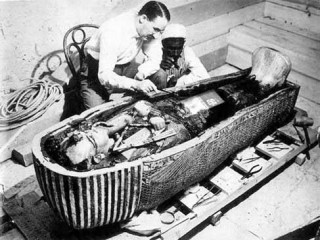
Howard Carter biography
Date of birth : 1874-05-09
Date of death : 1939-03-02
Birthplace : Kensington, London
Nationality : British
Category : Science and Technology
Last modified : 2010-04-27
Credited as : British archeologist/egyptologist, discoverer of the tomb of Tutankhamun, King Tut
0 votes so far
In 1891, at the age of 17, Carter, a talented young artist, was sent out to Egypt by the Egypt Exploration Fund to assist Percy Newberry in the excavation and recording of Middle Kingdom tombs at Beni Hassan. Even at that young age he was innovative in improving the methods of copying tomb decoration. In 1892 he worked under the tutelage of William Matthew Flinders Petrie for one season at Amarna, the capital founded by the pharaoh Akhenaten. From 1894 to 1899 he then worked with Edouard Naville at Deir el Bahri where he recorded the wall reliefs in the temple of Hatshepsut, the first female Pharaoh.
In 1899, Carter was appointed the first chief inspector of the Egyptian Antiquities Service (EAS). He supervised a number of excavations at Thebes (now known as Luxor) before he was transferred in 1904 to the Inspectorate of Lower Egypt. Carter resigned from the Antiquities Service in 1905 as a result of a dispute between Egyptian site guards and a group of French tourists.
Carter got his start as an artist, tracing Egyptian hieroglyphics for others, before becoming an archaeologist himself. His search for the tomb of King Tut took nearly a decade, including a lengthy interruption during World War I, and was supported financially by George Herbert, the earl of Carnarvon. Carter discovered the tomb of Tut on 4 November 1922 and opened the tomb after Lord Carnarvon's arrival at the site on the 26th of November. Ironically, Tutankhamen had been practically unknown before the discovery, but news coverage of Carter's amazing find made "King Tut" a household name.
Later work and death
The clearance of the tomb with its thousands of objects continued until 1932. Following his sensational discovery Howard Carter retired from archaeology and became a part-time agent for collectors and museums, including the Cleveland Museum of Art and the Detroit Institute of Arts. He visited the United States in 1924, and gave a series of illustrated lectures in New York City and other cities in the United States which were attended by very large and enthusiastic audiences, sparking egyptomania in the United States. He died of lymphoma, a type of cancer, in Kensington, London, on 2 March 1939[3] at the age of 64. The archaeologist's death, so long after the opening of the tomb despite being the leader of the expedition, is the most common piece of evidence put forward by skeptics to refute the idea of a "curse of the pharaohs" plaguing the party that violated Tutankhamen's tomb. His living descendants include Valerie Darroch, née Carter, and her family.
Carter is buried in the Putney Vale Cemetery. On his gravestone is written: "May your spirit live, May you spend millions of years, You who love Thebes, Sitting with your face to the north wind, Your eyes beholding happiness" and "O night, spread thy wings over me as the imperishable stars".
Extras : Lord Carnarvon died of pneumonia in 1923, reinforcing the legend of a curse placed on those who had disturbed Tut's tomb. However, Carter himself lived to the age of 64 before dying a natural death in England.
















